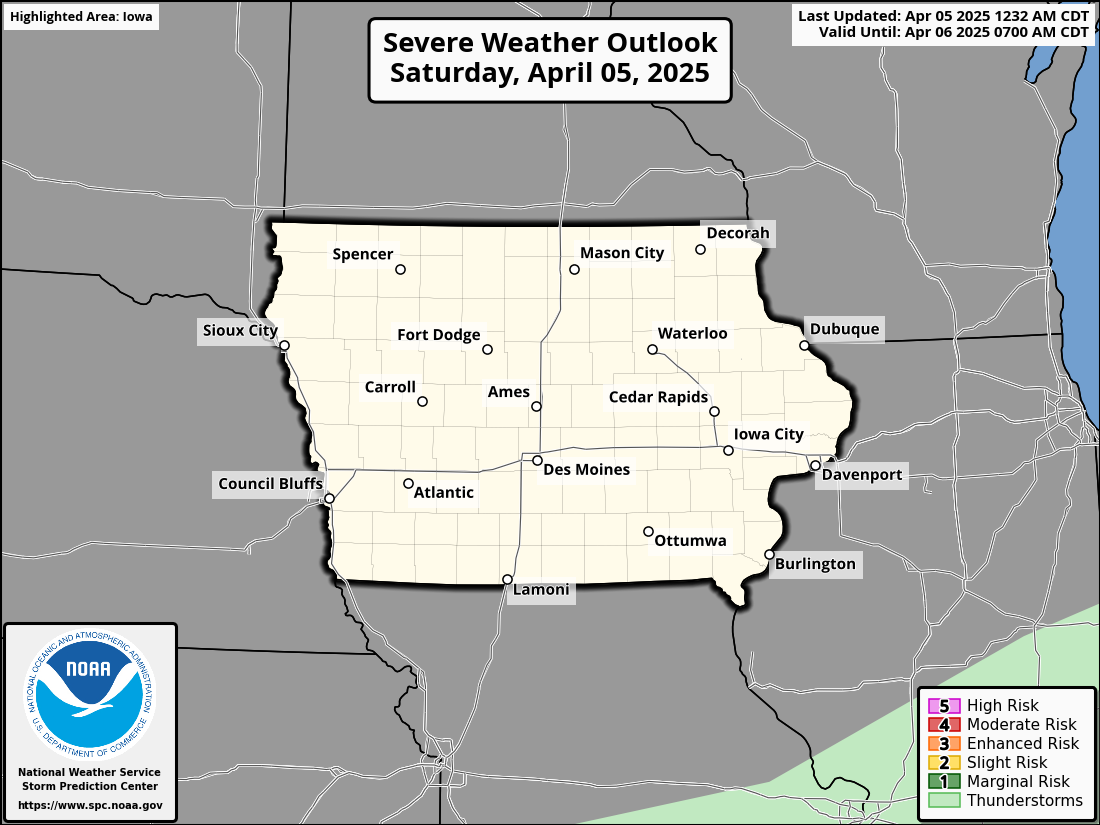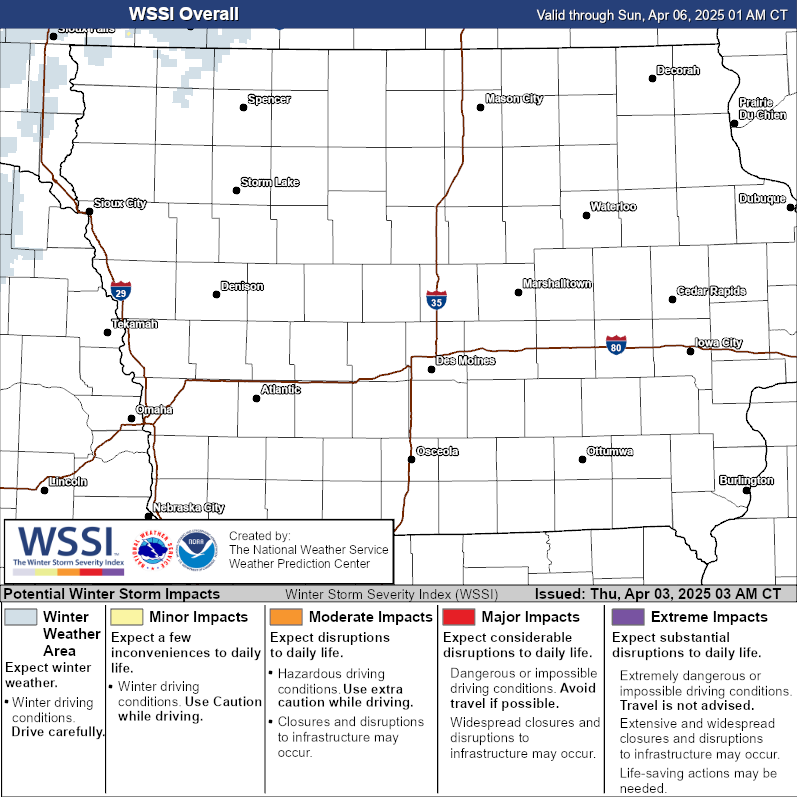Watches & Warnings (Iowa)
Last Updated: Loading...
Active Products
Loading...
Severe Weather Outlook
Day 1 Severe Weather Outlook

Winter Storm Severity Index
The Winter Storm Severity Index (WSSI) provides a graphic representation of the severity of winter weather conditions, helping to assess the impact of storms.

Iowa Road Conditions
Road conditions in Iowa provided by the Iowa State Patrol and Iowa Department of Transportation (Iowa DOT).

Ice Storm Warning: Hazardous Conditions Expected Starting Tonight
An Ice Storm Warning has been issued for Grundy, Tama, and Black Hawk Counties, with up to a quarter-inch of ice expected.
An Ice Storm Warning has been issued for Grundy, Tama, and Black Hawk Counties, taking effect at 8 PM this evening and continuing through 3 PM CST Saturday.
Forecasters expect one-tenth to one-quarter of an inch of ice accumulation, creating extremely slick surfaces on roads, sidewalks, and driveways. This amount of ice could easily bring down tree limbs and power lines, leading to potential outages and travel difficulties.
Residents in these affected areas are strongly encouraged to stay off the roads unless absolutely necessary. If you must drive, prepare for emergency situations. Keep an extra flashlight, non-perishable food, water, and warm clothing in your vehicle. At home, charge your devices ahead of time, have batteries on hand, and consider alternate heating methods in case the power goes out. It’s also wise to check on neighbors who might need assistance, especially older adults or those with limited mobility.
For the most up-to-date travel information, rely on official sources like the Iowa 511 app, the state’s travel website at www.511ia.org, or dial 511. Stay tuned to local news outlets and the National Weather Service for weather developments and possible changes to the warning. By taking these precautions and heeding the warning, you can help ensure your own safety and the safety of those around you as this ice storm moves through.
Continue Reading
Staying Safe During an Ice Storm: What You Need to Know
Ice storms can turn everyday tasks into dangerous challenges. From icy roads to power outages, here’s how to stay prepared and keep your family safe.
An ice storm can disrupt daily life in dangerous and unpredictable ways, turning roads into skating rinks, bringing down tree limbs, and leaving communities in the dark without power. With freezing rain expected to create hazardous conditions, officials are urging residents to take precautions now to stay safe.
Travel is one of the greatest risks during an ice storm. Even a thin layer of ice on roads can make driving treacherous, with vehicles losing traction and accidents becoming more likely. Experts advise staying off the roads if possible. If travel is unavoidable, make sure your vehicle is winter-ready. Carry essentials like an ice scraper, jumper cables, blankets, and a phone charger. Keep your gas tank at least half full to prevent freezing fuel lines and to ensure you have heat if stranded.
At home, preparations are equally important. Ice accumulation on power lines and trees often leads to widespread outages during a storm. Stock up on emergency supplies such as flashlights, batteries, non-perishable food, and bottled water. Ensure your mobile devices are fully charged, and consider investing in a portable power bank or generator. If you use a generator, follow safety guidelines to prevent carbon monoxide poisoning, including operating it outdoors and away from windows.
Walking outside during an ice storm can also be hazardous. Icy walkways and driveways are leading causes of slips and falls during winter weather. Spread salt, sand, or kitty litter on surfaces to improve traction and reduce risks. Avoid standing under trees or near power lines, as the weight of accumulated ice can cause branches or wires to collapse unexpectedly.
For those who rely on medications, medical devices, or other necessities, it’s essential to plan ahead. Refill prescriptions before the storm arrives and ensure medical equipment has backup power options. Stay connected with friends, family, or neighbors, particularly if you are elderly or live alone, to ensure someone checks in during prolonged outages or severe conditions.
Ice storms often develop and escalate rapidly, making it crucial to stay informed. Keep an eye on weather alerts and updates from reliable sources, such as the National Weather Service or your local emergency management office. Pay attention to warnings about road closures, extended power outages, or other community-specific hazards.
Continue Reading




